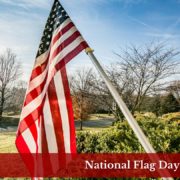Flag Day Trivia, Etiquette and Quotes
Today is Flag Day. The national observance commemorates the adoption by Congress of the Stars and Stripes as the flag of the United States on June 14, 1777, according to the National Flag Day Foundation.
The observance originated with a Wisconsin teacher who on June 14, 1885, placed a flag in a bottle on his desk and assigned students to write essays on the flag and its significance. That teacher, Bernard Cigrand, spent many years seeking national recognition of Flag Day. President Wilson on May 16, 1916, issued a proclamation for the national observance of Flag Day. In 1949, President Truman signed an Act of Congress designating the 14th day of June every year as National Flag Day. Flag Day is not a federal holiday but it is a state holiday in New York and Pennsylvania.
[clickToTweet tweet=”#FlagDayFact: There are six #AmericanFlags on the moon, five of which are still standing. ” quote=”FUN FACT: There are six American flags on the moon, five of which are still standing. “]
The National Flag Code outlines the proper handling and display of the United States Flag.
If you are planning to fly your Stars and Stripes, here are some things to remember about proper handling from www.usflag.org:
- The flag customarily is displayed from sunrise to sunset but it can be displayed 24 hours a day if it is lighted at night. It should not be displayed during inclement weather.
- The flag should be hoisted briskly.
- When displayed from a staff projecting horizontally or at an angle from the window sill, balcony or front of a building, the union of the flag should be placed at the peak of the staff unless the flag is at half-staff. When the flag is suspended over a sidewalk from a rope extending from a house to a pole at the edge of the sidewalk, the flag should be hoisted out, union first, from the building.
- The flag should never be displayed with the union down, except as a signal of dire distress in instances of extreme danger to life or property.
- The flag should never touch anything beneath it, such as the ground, the floor or water.
- The flag should never be carried flat or horizontally, but always aloft and free.
- The flag should never be used as wearing apparel, bedding, or drapery. It should never be festooned, drawn back, nor up, in folds, but always allowed to fall free.
- The flag, when it is in such condition that it is no longer a fitting emblem for display, should be destroyed in a dignified way, preferably by burning.
RELATED ARTICLE: American Flag Guidelines: How To Display and Care For The American Flag
Presidential proclamations or law allow for the U.S. flag to be flown 24 hours a day at:
- Fort McHenry, National Monument and Historic Shrine, Baltimore, Maryland
- Flag House Square, Baltimore, Maryland
- The United States Marine Corps Memorial (Iwo Jima), Arlington, Virginia
- On the Green of the Town of Lexington, Massachusetts
- The White House, Washington, D.C.
- United States Customs Ports of Entry
- Grounds of the National Memorial Arch in Valley Forge State Park, Valley Forge, Pennsylvania
Some interesting facts about the American flag
Today, we join millions of Americans as we take great pride in flying our Made in USA American flags. Need to purchase one? Check out our friends at The Made in America Store where you can pick up any size Made in USA American Flag!
“The American flag, Old Glory, standing tall and flying free over American soil for 228 years is the symbol of our beloved country. It is recognized from near and afar, and many lives have been lost defending it.” – – Jeff Miller
SOURCE: USAFlag.com
Click here for the top 4 reasons buying Made in USA has a bigger impact than you know.
Learn how you can become a MAM brand ambassador and help support the Made in America Movement.





Trackbacks & Pingbacks
[…] The proper way to display the flag […]
Leave a Reply
Want to join the discussion?Feel free to contribute!